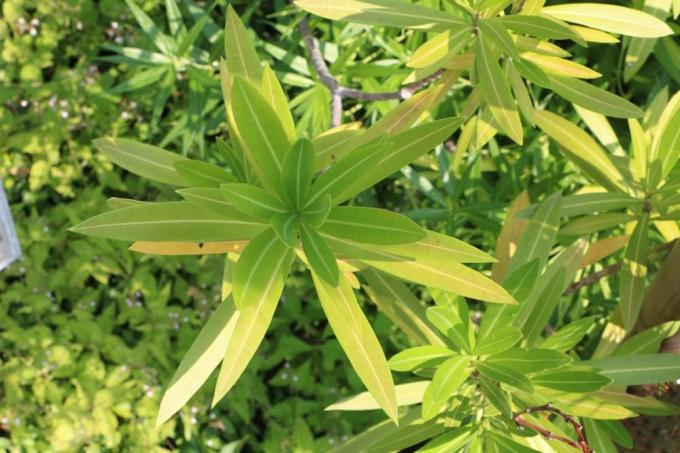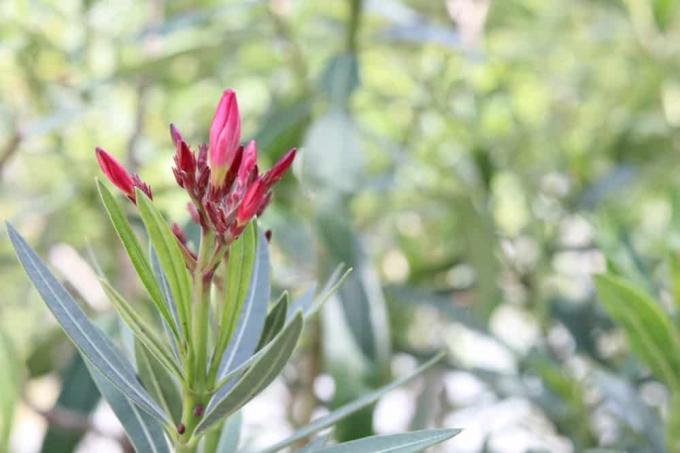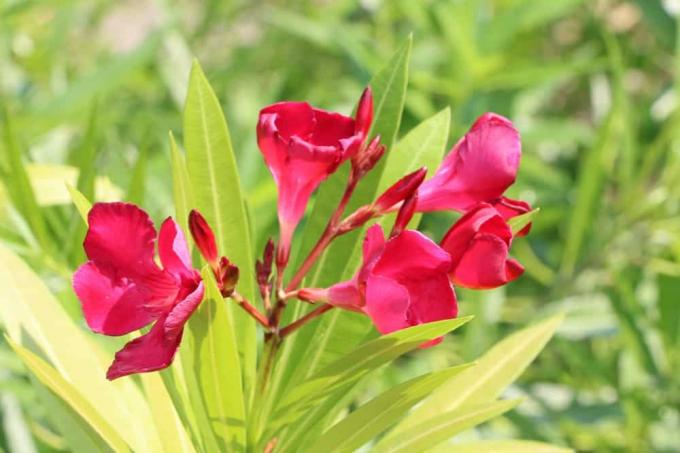

Table of contents
- Care
- Location
- substrate & soil
- Fertilize
- Pour
- Plant
- Cut
- multiply
- hibernate
- repot
- Care mistakes, diseases or pests
Oleander is also very popular in the local latitudes. Due to its limited winter hardiness, however, it is advisable to cultivate the flowering shrub in a bucket. So it can easily be spent in the summer on the terrace, balcony or in the garden, and over the winter the plant can be placed in a container in a sheltered place.
Care
The oleander is quite easy to care for when given the right conditions and is then also a grateful plant that will reward you with profuse flowering throughout the summer months.
Location
Due to its origin in the Mediterranean region, the oleander is used to the blazing sun and therefore also wants a full sun spot on the terrace, balcony or in the garden. But the plant can also cope well with a bright location in semi-shade. It is ideal if the oleander is protected from the rain under a roof overhang. So the following locations are ideal for the decorative plant:
- in the front yard next to the front door
- on a sunny, covered terrace
- on a south-facing balcony, which also has a roof
- in the garden in a sunny corner
- bright, frost-free place in winter
- hallways or conservatories are suitable
- gradually get used to the sun after the winter quarters
- partial shade is therefore ideal for the first few weeks
Tip:
Due to the ice saints, the move from the winter quarters should only take place in mid-May, when no more night frosts are to be expected.
substrate & soil
The oleander has a high nutrient requirement and therefore the commercially available potting soil is well suited for potted plants. Garden soil that has been mixed with compost is also ideal for the decorative plant to thrive. In addition, the soil should be quite calcareous.
Fertilize

Oleander needs a lot of fertilizer to show its beautiful blooms in all their glory in summer. Therefore, it makes sense to start fertilizing in early spring, when it is still in its winter quarters. The following fertilizers are well suited for the plant:
- Liquid fertilizer for flowering plants
- fertilize every two to three weeks
- give with the water
- is particularly suitable for plants cultivated in tubs
- Long-term fertilizer for flowering plants
- use chopsticks that are simply stuck into the ground
- these release fertilizer regularly
- for replacement, pay attention to the manufacturer's instructions
- add lime regularly
- from autumn before moving to the winter quarters, stop fertilizing
Of course, compost is also suitable for fertilizing oleander, but if it has been cultivated in a bucket, then the fertilizer application of compost is not very easy. But with regular repotting, compost can also be mixed into the fresh soil.
Tip:
The oleander likes it calcareous. Lime should therefore also be regularly mixed into the soil. It is also helpful to water with hard water. Therefore, with this plant, you should avoid collecting rainwater, which usually contains little or no lime.
Pour
During its main growing season in summer, the oleander needs a lot of water. Plants that have been cultivated in tubs and are in full sun dry out faster than tub plants in the shade or plants in the garden bed. It is therefore important that the plant receives plenty of water, especially in the hotter months. To do this, proceed as follows:
- like to water in the morning and evening during high heat
- Water may also remain in the collecting plate
- Water every two to three days in spring and fall
- always from below directly to the roots
Tip:
If potted plants have a place under a roof, but even without protection from above, they will not receive enough water when it rains. Because often the rainwater does not reach the earth in the bucket. Therefore, the oleander plants in the tub must also be checked for sufficient water and moist soil during a rainy period and watered if necessary.
Plant

Ideally, the oleander is cultivated in a bucket due to its limited winter hardiness. Depending on the size of the plant, the vessel size is chosen. Then proceed as follows:
- create drainage
- put pebbles or expanded clay on the drain hole
- Lay on plant fleece
- Fill potting soil or garden soil halfway with compost
- Use oleanders
- Fill in the rest of the soil and press down well
- water sufficiently
- Spend the bucket at the desired location
Tip:
An oleander cultivated in a tub can be planted at any time. However, spring is still the best time for this.
Cut
The oleander should only be pruned a little and very carefully. Because the new flowers for the next year are formed before the hibernation. If the shoots are all removed, the plant will sprout again next year, but it will not flower. Therefore, when cutting, the following should be observed so that the plant is in full bloom again every year:
- Carefully pluck off faded leaves
- this encourages the formation of new flowers
- only cut when the oleander is out of shape
- make a cut immediately after the first flowering
- cut a few shoots directly above the soil base every year
- so the oleander grows nice and dense
- never make a radical cut in the fall
- use a sharp pruning shears or saw
- Always disinfect tools
When pruning the oleander, but also when plucking the withered flowers, it is advisable to protect your hands with gloves and to wear long clothes. Because the plant is poisonous in all parts and plant juice can escape when pruning, which should be avoided if it touches the skin.
Tip:
The tools used should always be sharp and disinfected. To do this, clean the scissors or saw well and disinfect with pure alcohol from the pharmacy. If the cutting tool is unclean or out of focus, it is easier for bacteria or viruses to penetrate the plant and damage it overall.
multiply

The oleander can easily be propagated by cuttings. The shoots cut after flowering can be used for this. When using cuttings, proceed as follows:
- remove lower leaves
- put in a glass with water
- put in a warm and bright place
- avoid full sun exposure
- after some time roots will form
- then plant in pots
- from autumn into a bright, cool, frost-free room
- do not place in the blazing sun in spring
- Fertilize and water regularly from spring
If you grow an oleander from cuttings, you can expect dense flowering of the fast-growing plant after two to three years.
Tip:
With a young oleander plant from a cutting, care should be taken in the first year that it is under no circumstances exposed to the first night frosts in autumn.
hibernate
The oleander is only partially hardy, which means that the plant can tolerate light frost, but should be better protected in the local latitudes. The shoots in particular are at risk when it gets cold. If these die off due to frost, the plant will sprout again the next year, but there will be no flowering because the buds form on the shoots before winter. Therefore, the oleander should be overwintered as follows:
- the evergreen plant needs a light location
- this should not be too warm in winter
- a corner in the heated living room is therefore not suitable
- a bright hallway or bright stairwell is ideal
- an unheated conservatory is also suitable
- Oleander is also decorative in winter due to its leaves
- switch before the first frost in autumn
- Check for pests before moving in
- remove old flowers
- water only moderately in the winter quarters
In winter, cool temperatures of up to 15° Celsius are ideal for the plant. The darker the room, the cooler the temperatures can be. However, ideal winter temperatures are between 2° and 10° Celsius, otherwise there is a risk that the plant will be attacked by scale insects.
Tip:
If you cannot find a suitable place for winter quarters, you can also place the bucket on Styrofoam Wrap the entire plant including the tub in plant fleece and place in a protected corner on the patio or balcony place. The oleander survives light frosts down to -5° Celsius without protection.
repot

The oleander should be repotted regularly, at least every two to three years. This is not only related to its growth, this way the plant in the bucket also gets a fresh substrate. The ideal time to repot is when the plant moves back outside from its winter quarters. When repotting, the following should be considered:
- choose a new, slightly larger planter
- carefully remove the oleander from the old tub
- prepare new pot with drainage
- Half fill with fresh soil
- Remove old soil from roots
- Briefly dip the root ball in water
- then put in new bucket
- Fill in the remaining soil and press down
- water sufficiently
Tip:
Depending on the size of the plant, it may be helpful to have two people do the work. In this way, one person can hold the bucket while the other carefully removes the plant. Gloves and long clothing should also be worn for this work due to the toxicity of the plant.
Care mistakes, diseases or pests
Unfortunately, there are also some mistakes in care that could harm the oleander. It can suffer from a lack of lime, which is indicated by pale leaves. However, these also occur if too little fertilizer is given and the plant lacks nutrients as a result. If, on the other hand, the leaves turn yellow and fall off in summer, then this is no reason to worry, because this is the natural shedding of leaves when the leaves change. Brown edges on the edge of the leaf appear when the oleander stands in the blazing sun in spring directly after hibernation. But here, too, new leaves grow quickly. The following are known pests:
- is often attacked by scale insects
- especially in winter quarters
- regularly check for insects
- wash off if infested
- possibly change location
- use insecticides
 garden editorial
garden editorial I write about everything that interests me in my garden.
Learn more about deciduous trees in the garden

Eucalyptus tree: 11 tips for care & overwintering
If you want to enjoy the beauty of the eucalyptus for many years, you should pay a lot of attention to the tree in summer. In most cases, the wood does not forgive mistakes in care. In winter, precautions are necessary so that the frost does not leave any damage.

Hop beech, Ostrya: profile, special features and care
The common or European hop beech is the Austrian "Tree of the Year 2019". Despite its name, this little-known but widespread deciduous tree bears no relation to beech or hops. The German species name refers to external similarities.

Cut weeping willow and hanging catkin willow
Mighty weeping willows or small hanging catkins, two species of one genus (Salix) could hardly be more different. While a dainty hanging willow can decorate almost any garden, balcony or terrace, the romantic weeping willows only really come into their own in larger areas. A professional cut a year, however, suits both well "to the crown".

Japanese Maple, Red and Japanese Maple - Care Instructions
Japanese maple only reveals the furious blaze of color of its decoratively lobed ornamental leaves at the end of the gardening season. The top priority for the autumn spectacle is the consideration of important aspects such as ideal site conditions, a balanced water and nutrient balance or planned pruning measures. These care instructions provide practical information on how to take care of your red and Japanese maple professionally.

Silk tree, Albizia julibrissin - cultivation and care - is it hardy?
With its extraordinary foliage and the extremely decorative, delicately scented flowers, the silk tree astonishes its viewers. This beautiful plant is still relatively rare to find in this country. It is conditionally hardy and is mainly kept as a container plant. In warm regions, however, it can also be planted out in the garden.

Plane tree - care, plant, cut properly
A roof plane tree is ideal for creating a small, shady seat in the garden. Properly trimmed, the roof plane tree forms, as the name already suggests, a flat canopy of leaves under which you can linger wonderfully. It also brings a pleasant Mediterranean flair to the local gardens.
